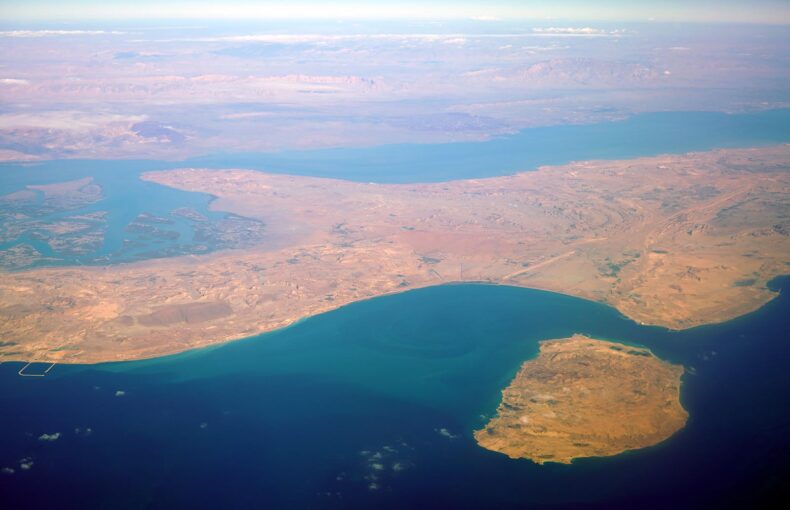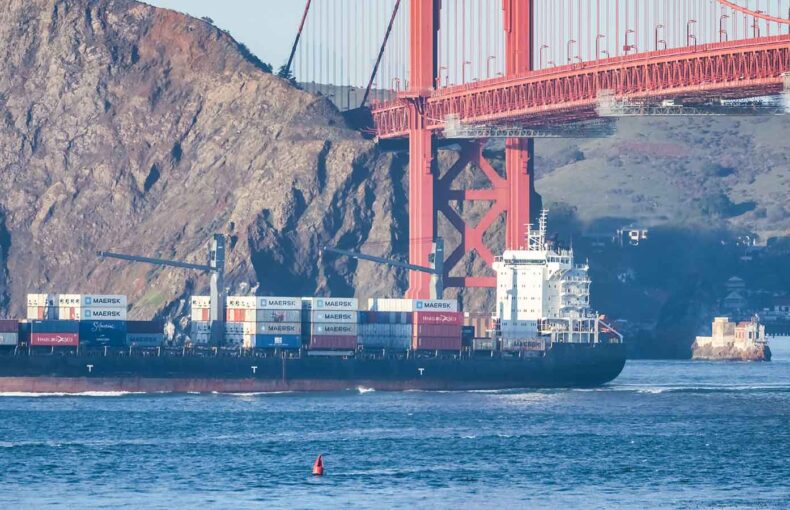What Makes the Port of Jebel Ali a Wonder
In less than five decades, the Port of Jebel Ali has grown into one of the world’s ten busiest ports. It is vital to the infrastructure and economy of the entire Gulf region and the center of the United Arab Emirates’ economy.
Jebel Ali handles traffic for the vital Strait of Hormuz and the entire Arabian Gulf, plays a crucial role in the global oil industry, and is the most frequented port of call for the US Navy outside of the United States.
It is the world’s largest human-constructed harbor and an industrial marvel whose port operations are supplemented by cutting-edge tech like Automatic Identification System (AIS ) maritime data, autonomous internal terminal vehicles (AITVs), and BoxBay storage. The port of Jebel Ali has an already impressive history of being recognized as one of the world’s best managed and most innovative port operations.
Jebel Ali: A High-Traffic Port
The first and foremost fact about the Port of Jebel Ali is its importance to the region. Port operations handle over 13 million 20-foot equivalent units (TEUs) and it is the world’s ninth busiest port, making it the leader of the pack in the region, handling as much material as the next four major Middle Eastern ports combined.
Located a short distance up the coastline from Dubai, the flagship port of the United Arab Emirates (UAE) hosts over 5,000 companies on its sprawling 52-square-mile site. With its 67 berths and ability to host the world’s largest ships, from supertankers to container ships to aircraft carriers, it is not just a regional transportation hub but also key for logistics of global import.
Operated by Dubai-headquartered DP World—the huge maritime logistics conglomerate that handles roughly 10% of the world’s container traffic annually at their 90-plus terminals in over 40 countries—Jebel Ali has consistently been on the cutting-edge of shipping technology and port operations.
But the challenges the COVID-19 pandemic presented to the shipping industry, including a shortage of TEUs and growing port congestion, have taken a toll on Jebel Ali; the volume of containers handled at the port is still below the peak year of 2015. However, 2021 was marked by a continuing rebound of traffic, with a total of 13.7 million TEUs handled, an increase of 1.9% over 2020.
“As expected, growth rates moderated in the final quarter of 2021 as the new COVID variant, inflation and supply chain bottlenecks impacted global growth,” wrote Group Chairman and CEO of DP World Sultan Ahmed bin Sulayem in his report for 2021. “However, looking ahead to 2022, we expect our portfolio to continue to deliver growth and, while the year has started encouragingly, we remain mindful that the COVID-19 pandemic, continued supply chain disruptions, rising inflation and geopolitical uncertainty could continue to hinder the global economic recovery.”
As Sulayem noted at Expo 2020, held in Dubai in October, “These are the complications. Nobody knows how long it’s going to take. I think it’s going to take a long time. The problem is complicated because you have a backlog of cargo.”
Container Ships Vessel Routes Throughout the Pandemic
Source of data: Satellite, Terrestrial, Enhanced Satellite AIS
Jebel Ali, May 10th-17th 2019
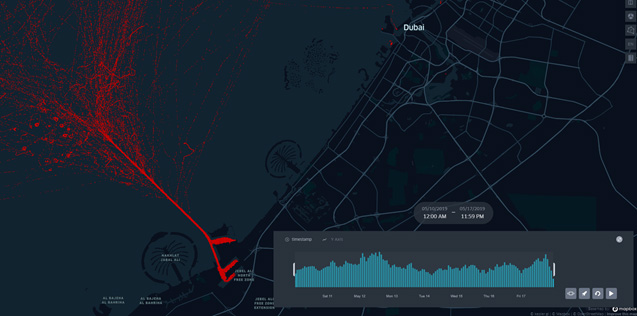
Jebel Ali, May 10th-17th 2020
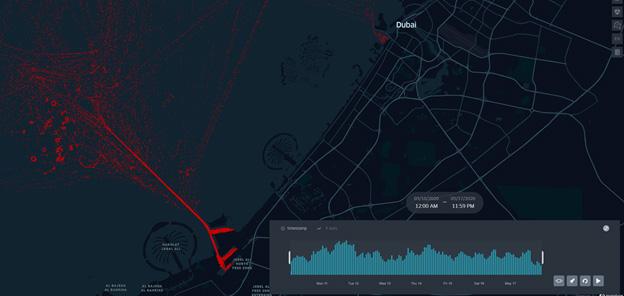
Jebel Ali, May 10th-17th 2021
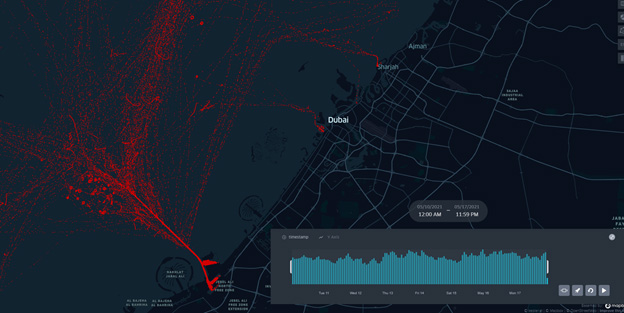
The Challenge of Congestion
Like other major ports in the world, the chaos of the global pandemic has only exacerbated the longstanding challenge of port congestion.
This was brought home to Jebel Ali very directly in July of 2021 when a fire on a container ship led to an explosion that rocked the area. Emergency personnel doused the flames in short order but it was a reminder of the risks and challenges of getting ships in and out of port without any mishaps.
The fact is that everyone in the shipping industry has had a long couple of years—as has everyone. But long wait times at ports due to COVID-19 protocols and strains throughout the supply chain raise the risk of things going wrong.
Port congestion tools, like the Spire Maritime 2.0 API, show that ships are still waiting more than a day to get into port, twice the six-month average:
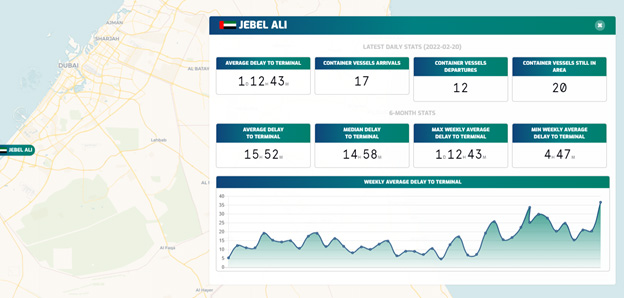
This is a demo tool for the Predicted ETA feature of the Spire Maritime 2.0 API. The full API response contains much more information besides turnaround times, like vessel location information, predicted route, or vessel characteristics.
These challenges demand new technology that more efficiently moves ships into place and handles them after they’ve docked.
Enhanced Satellite AIS
One developing capability being brought to bear, as it is in many other economic contexts, is Big Data.
One way to prevent port congestion is to carefully coordinate the arrivals of ships that are incoming from myriad directions, especially at bottlenecks and on approach. That demands the ability to track the exact location of many vessels simultaneously, including their expected travel times from points A, B, C, and beyond.
Maritime AIS data, especially for high-traffic zones and busy shipping lanes, can provide the kind of information that port operations can use to coordinate access. Spire Maritime’s Enhanced Satellite AIS is one example of the kind of Big Data operation ports are turning to. One of the major challenges that arises at busy ports and high-traffic zones is AIS data gaps. Enhanced Satellite AIS minimizes these data gaps by using three types of AIS coverage—Satellite, Terrestrial, and Enhanced Satellite—which ultimately give port managers and harbor pilots the information they need to lessen congestion.
As the visuals below demonstrate, in high traffic zones Enhanced Satellite AIS provides better coverages and fills the gap of Satellite + Terrestrial AIS. With Enhanced Satellite AIS, we are able to collect more AIS messages and more unique vessels.
Jebel-Ali Vessel Positions, January 10th-17th 2022
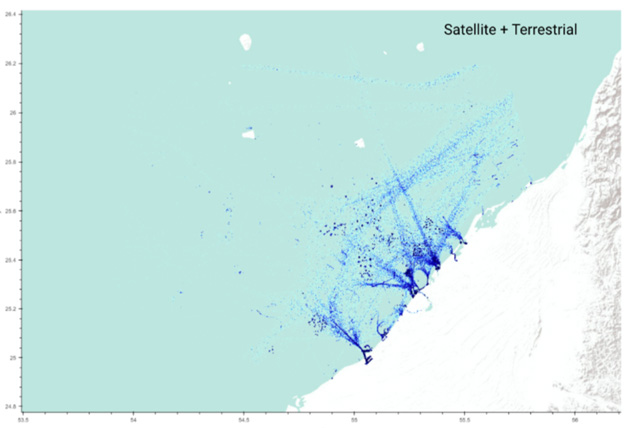
Satellite + Terrestrial: Total AIS Message Count: 1244732 | Unique Vessel Count: 1,774
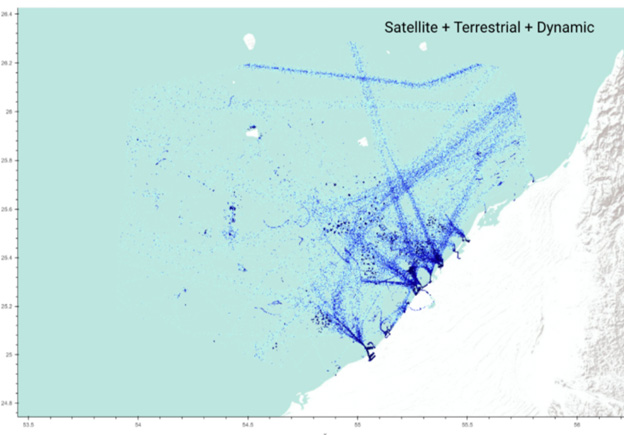
Satellite + Terrestrial + Enhanced Satellite: Total AIS Message Count: 2,167,276 | Unique Vessel Count: 1,943
Want to see more of Enhanced Satellite AIS in action?
Autonomous Internal Terminal Vehicles (AITVs)
Once ships are in port, getting goods and cargo offloaded is the priority. The Port of Jebel Ali is exploring new solutions in this area, including the incorporation of AITVs into on-the-ground transportation. This is an extension of the ongoing digitalization of port operations. This investment will boost terminal efficiency and decrease the number of vehicles required on the docks. The underlying tech is AI-based decision-making software that will use localization data and georeferencing to move the port’s fleet of vehicles around as they transport TEUs.
“The DGWorld autonomous control system is specially designed to match the driving dynamics of heavy industrial vehicles such as the container trucks to be converted for Jebel Ali Port,” explained Matthias Krause, the general manager of DGWorld, the Dubai-based developer of automated vehicles and robotics. “The accuracy and output data rate of the Xsens MTi are perfect for this application.”
A Port That Grew Out of the Desert
Adapting to new tech comes naturally at the Port of Jebel Ali. Not a historic harbor, the area was sparsely populated before the massive dredging operation that created the modern port.
Its creation in the mid-1970s as a supplement to Port Rashid—built in 1972 and since converted into a cruise terminal—was based on the latest engineering and explains why it quickly became the region’s dominant port. This was a trajectory realized at the time, given that it was a conscious decision to make Dubai a trade center in the modern world. And it explains why Great Britain’s Queen Elizabeth II—as the official guest of Sheikh Rashid bin Saeed, the UAE’s ruler from 1958 to 1990—oversaw its formal inauguration in 1979 after the British royal yacht HMY Britannia sailed into port.
Today the port is the anchor of the Jebel Ali Free Zone (Jafza), considered the world’s largest site of operations for over 8,700 businesses and 350,000 employees. It contributes 21% to the overall GDP of Dubai.
“Naturally the port stimulates the economy, the port generates jobs for people. The port makes it much more efficient to import and export so it stimulates trade,” noted Sulayem to Gulf Business. “When we go to the schools and explain what we do and get people at least thinking that maybe when I graduate or choose my education I’ll be in logistics.”
Linked directly to Dubai International Airport Cargo Village via expressway, the port boasts both a container yard and an open storage area of over 10 million square feet each. Along with its container freight station (CFS), the port’s 28 berths at four terminals handle a wide range of cargo requiring cool/cold storage—including produce, pharmaceuticals, and cosmetics—and bulk, breakbulk, and roll-on/roll-off (ro-ro). The port handles cargo from Africa, Asia, Europe, the Americas, and the rest of the Middle East.
Port operations have long been recognized as being some of the best in the world. Jebel Ali has won numerous awards, such as “Best Sea Port—Middle East” for consecutive years by the Asian Freight, Logistics and Supply Chain (AFLAS) and the “Golden Award” from the Higher Committee for UAE Civil Seaports and Airport Security. DP World is widely acknowledged as one of the most forward-looking port managers in the world—one that is constantly looking to adapt new technologies to enhance its logistical operations. This is a cornerstone of Dubai’s long-term economic strategy of becoming a Global Hub for Innovation.
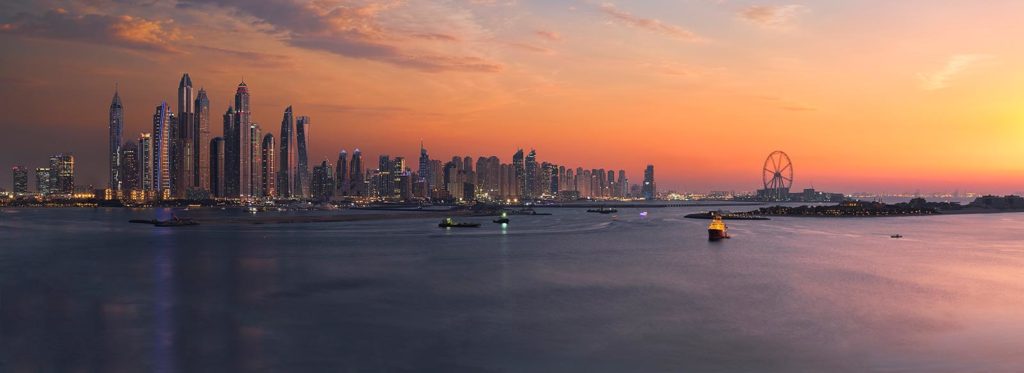
Looking to the Future
An important aspect of this is realizing the need for sustainable solutions in a world where climate change is an ongoing risk. Given how vulnerable the UAE is to rising sea levels and the potential impact on coastal ecosystems, finding more sustainable methods for port operations is a priority that will help mitigate this risk.
The entire harbor is constantly being scrutinized for water quality issues using a wide variety of monitoring equipment, from permanent internet of things (IoT) probes to supplementary in-person observation to constant laboratory testing of samples. DP World employs a team of divers, drone operators, patrol boat crews, and CCTV technicians to gauge conditions at all times. There is also a custom-built cleaning skimmer that monitors and cleans the port.
Not surprisingly, as part of Dubai’s goal of producing 75% of its energy from renewable sources by 2050, the port is fully committed to adapting its power grid. In 2016, DP World began the installation of 88,000 solar panels on its warehouses and other facilities in and around the port. The goal is to produce 40% of Jafza’s electrical needs onsite. Complimenting these efforts are high-tech sensors and smart metering that limit the use of electricity in port operations, along with doing everything possible to curtail carbon-emitting equipment.
The incorporation of Maritime AIS data is also crucial to curtailing the congregation in the port area of ships waiting to berth. It can also be used to track ships to ensure they don’t enter or disturb protected or sensitive ecological areas, such as the nearby Jabal Ali Wetland Sanctuary, which was established in 2018. It is home to coral reefs, mangroves, and seagrass beds that are home to over 300 species, including endangered species of turtles and rays.
One way to protect nearby areas is to lessen the footprint of the port moving forward. One exciting new project is the installation of the BoxBay high-bay storage system. Like the magnificent skyline of Dubai—home to Burj Khalifa, the world’s tallest building—going up is a far better ecological choice than sprawling out. The Port of Jebel Ali just hosted the first-in-the-world installation of this exciting new technology in partnership with the German engineering firm SMS Group.
BoxBay, which incorporates a sophisticated electrified, automated crane lift system, allows for the stacking of up to 11 stories of TEUs in a series of rows and potentially tripling storage capacity over a conventional yard. This reduces the terminal footprint by 70%. It radically reduces the need to reshuffle containers around a yard, which is a mundane task that accounts for approximately half of all container movements in most ports. Solar panels atop the BoxBay structure can power the entire operation.
The Port of the Future – Today
Jebel Ali is clearly not only one of the world’s most important ports but a leader in infrastructure development of any kind. It has grown in less than 50 years to become the lynchpin of the UAE’s economy as the core of the free trade zone.
Forty-three years after his mother christened it, Prince William recently made the second British royal visit to the port.
“The sheer scale of Jebel Ali Port is phenomenal,” tweeted the Duke, something the Queen doubtless could not have imagined during her visit. “Heralded the ‘engine’ of Dubai, this is one of the busiest ports in the world, seeing thousands of containers and cargoes go through it every day.”
 Written by
Written by
